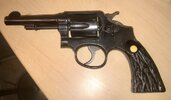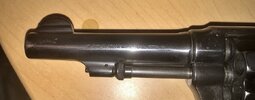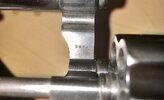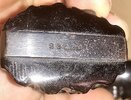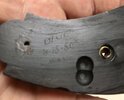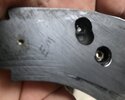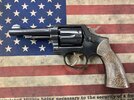You are using an out of date browser. It may not display this or other websites correctly.
You should upgrade or use an alternative browser.
You should upgrade or use an alternative browser.
S&W help
- Thread starter Steel Hayes
- Start date
Oldschool shooter
Member
It looks to be an old M&P. Later versions were called the Model 10. The grips are aftermarket. Looks to be in decent shape. How is the lockup?
Steel Hayes
Member
Very tight.
I don’t believe it was shot a lot.
I don’t believe it was shot a lot.
jar
Contributing Member
Likely dates to somewhere between 1913 to 1915.
Dave Markowitz
Member
Condolences on your loss.
That is a M-1905 Military & Police, 3rd Change, made between 1909 and 1915. (I looked up the serial number in my Standard Catalog of Smith & Wesson). If that hasn't been refinished it is in exceptional shape for its age. As mentioned by someone above, the grips are aftermarket.
Assuming that the timing and lockup are good, it's safe to shoot with standard pressure .38 Special ammunition. Note that while it's made from steel, S&W did not heat treat the revolvers until about 1919. It should shoot close to point of aim with 158 grain standard pressure loads.
Do not shoot any +P ammunition in it. It is unlikely to blow up but will greatly accellerate wear and tear.
That is a M-1905 Military & Police, 3rd Change, made between 1909 and 1915. (I looked up the serial number in my Standard Catalog of Smith & Wesson). If that hasn't been refinished it is in exceptional shape for its age. As mentioned by someone above, the grips are aftermarket.
Assuming that the timing and lockup are good, it's safe to shoot with standard pressure .38 Special ammunition. Note that while it's made from steel, S&W did not heat treat the revolvers until about 1919. It should shoot close to point of aim with 158 grain standard pressure loads.
Do not shoot any +P ammunition in it. It is unlikely to blow up but will greatly accellerate wear and tear.
Driftwood Johnson
Member
Howdy
I agree. 38 Military and Police Model of 1905, 3rd Change. This model was made from 1909 until 1915. Serial numbers ran from 146900 through 241703. The numbers on the frame under the cylinder yoke ( the cylinder hinge) are assembly numbers and mean nothing. The Serial Number of record is on the bottom of the butt.
Here is a photo of a 38 Military and Police Model of 1905 4th Change. It shipped in 1917. This one is a target model with a tall front sight and tiny adjustable rear sight. This is what the original grips would have looked like on your revolver. Notice there are four screws holding down the side plate. Yours will have the same arrangement, with one more screw in front of the trigger guard making it a "Five Screw" Smith. Also, notice the large, mushroom shaped cap on the front of the ejector rod, similar to yours. These large caps were typical of these early Military and Police revolvers.

I agree. 38 Military and Police Model of 1905, 3rd Change. This model was made from 1909 until 1915. Serial numbers ran from 146900 through 241703. The numbers on the frame under the cylinder yoke ( the cylinder hinge) are assembly numbers and mean nothing. The Serial Number of record is on the bottom of the butt.
Here is a photo of a 38 Military and Police Model of 1905 4th Change. It shipped in 1917. This one is a target model with a tall front sight and tiny adjustable rear sight. This is what the original grips would have looked like on your revolver. Notice there are four screws holding down the side plate. Yours will have the same arrangement, with one more screw in front of the trigger guard making it a "Five Screw" Smith. Also, notice the large, mushroom shaped cap on the front of the ejector rod, similar to yours. These large caps were typical of these early Military and Police revolvers.

Pat Riot
Contributing Member
I love the font of that serial number on the butt. 
I would stick with lead ammo and never try +P ammo in that revolver.
I am sorry to hear that your father passed.

I would stick with lead ammo and never try +P ammo in that revolver.
I am sorry to hear that your father passed.
Steel Hayes
Member
Wanted to thank everyone for the great information.
Pulled the plate thinking there would be 100 years of crud, evidently my father meticulously kept the revolver pristine.
It may only get to shoot a few wadcutter’s and it’s time to find a set of original grips.
Pulled the plate thinking there would be 100 years of crud, evidently my father meticulously kept the revolver pristine.
It may only get to shoot a few wadcutter’s and it’s time to find a set of original grips.
jar
Contributing Member
While the grips are almost certainly not original don't be too fast replacing them. They look like they might be horn with real ivory inserts and could be more valuable monetarily than the gun. See if there is any indication of a maker on the backside and treat them gently.
Steel Hayes
Member
J-Bar
Member
Sorry for the blurriness, my phone wouldn't focus on something that small.
One trick to keep in mind; take a bunch of photos from a distance that makes your subject as sharp as possible. Pick the best one and delete the rest. Edit the good one by cropping it to show an enlarged view of your subject. Pretty easy to do on today's phones.
halfmoonclip
Member
- Joined
- Feb 4, 2011
- Messages
- 2,805
Steel Hayes, great gun, great provenance.
One question; you pulled the sideplate? It's not hard, but there is a trick to it.
Moon
One question; you pulled the sideplate? It's not hard, but there is a trick to it.
Moon
Steel Hayes
Member
Removed the 4 screws and the grips, the small space by where the frame and the main spring is, easy to pop up.One question; you pulled the sideplate? It's not hard, but there is a trick to it
jar
Contributing Member
For future.Removed the 4 screws and the grips, the small space by where the frame and the main spring is, easy to pop up.
It's not a good idea to pry off the side plate. Instead try taking the screws out and tapping on the other side of the frame.
Riomouse911
Member
Ya, there is a tiny machined lip on the edge of the side plate that fits in a recess in the frame to hold it together. The standard removal method is to flip the gun so the side plate faces down and tap with a tool on the edge of the grip frame to loosen it for removal. The lip is very small and the fit precise, it can get bent/damaged if you pry it up.For future.
It's not a good idea to pry off the side plate. Instead try taking the screws out and tapping on the other side of the frame.

My older M&P .38 was my great uncles duty gun from 1945-1965. He added the grips, I did have it reblued to cover a couple of deep scratches and a lot of bluing wear from holsters and sweat. I only shoot standard pressure loads through it and it shoots very well.
I am sorry for your loss, hopefully you can make some great and lasting memories with the firearm you were given.
Stay safe.
Attachments
Speedo66
Member
Perhaps needless to mention, but that tapping should be done with a wooden tool.
Steel Hayes
Member
I appreciate the thought.am sorry for your loss, hopefully you can make some great and lasting memories with the firearm you were given.
Made some good memories this weekend with my 3 boys and some wadcutter’s.
Similar threads
- Replies
- 65
- Views
- 4K
- Replies
- 21
- Views
- 2K


